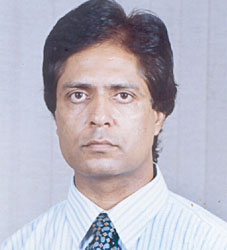Ali Shadman Reveals the Secrets of Cloud Computing
Only the mysteries of Egyptian mummies come somewhere close to the extent of enigma that cloud computing has brought to the tech markets.
Cloud sellers seem to be running very fast but going nowhere.
And user companies are more confused than enthused over the cloud concept.
Is cloud for real? Or is it also headed for the graveyard of those tech tales that couldn’t live up to their hype?
Ali Shadman, chief technologist of Hewlett-Packard Company (HP), is sure he can unravel the knotty concept in moments.
Here he discusses the present and future of cloud computing in an exclusive interview with Rakesh Raman, managing editor, Raman Media Network.
Here’s what he says:
1. Cloud computing has largely been a topic of discussion for tech seminars while its real adoption has been very slow. Is cloud computing a rhetoric or reality?
Cloud computing is becoming a reality. Recent research from HP indicates that by 2015, senior business, government and technology executives believe that 18 percent of their IT delivery will be via the public cloud and 28 percent by private cloud. The remainder will be in-house or outsourced.
As businesses and governments increase expectations on technology, IT is tasked with delivering on-time, on-budget technology-enabled services. Companies are adopting public, private and hybrid cloud delivery models at an increasing pace in order to respond to shifting business demands.
At HP, we are witnessing an increasing demand for capabilities that help companies transition to the cloud in an effective and cost efficient manner. I believe we will continue to see this demand escalate and must recognize we have yet to explore or experience the full potential of cloud computing.
2. What could be the inspiration for enterprises to migrate to cloud platforms while ignoring their pre-existing backend systems and the investments made on them?
Cloud computing is capturing the interest of enterprise leaders because it enables companies to respond quickly to constantly changing business demands. ‘The Cloud’ allows companies to have immediate access to multiple applications in a distributed, international workforce and lowers costs, decreases the data-center footprint and improves efficiency.
In addition, more enterprises may migrate to cloud platforms as the deployment into the cloud becomes quicker. For example, the new 3PAR with HP Cloudsystem is shown to allow clients to reduce cloud application deployment time from days to minutes, while at the same time improving operational efficiency of storage management tenfold and cutting storage costs by up to 50 percent.
3. When it takes off, will cloud computing be equally useful for all user segments – large, medium, and small?
Cloud computing technology is quickly evolving to meet and improve upon the demands of all user segments, whether they be large, medium or small. We have delivered services and helped businesses and enterprises on a variety of levels deploy into the cloud and as a result, improve their efficiency and increase their return on investments.
4. In general, cloud computing shifts the information and processing load from enterprise data centers and frontend systems to service provider’s infrastructure. So instead of using PCs, can user organizations hope to see totally frill-free frontend boxes – at the cost equivalent to that of, say, a normal mobile phone?
Cloud computing definitely has potential to significantly change technology. As more and more users begin to recognize and utilize the full potential of the cloud, technology and businesses will adopt to meet these demands. While it is difficult to predict or determine the affordability and evolution of technology, we have seen that cloud computing allows companies to increase their efficiency at a lower cost – which could be passed along to their customers.
5. In other words, can cloud computing usher in a new era to see the end of Wintel (Windows + Intel) systems?
Cloud represents a significant shift in delivery of IT services. These services can be consumed on many endpoint devices such as mobile phones, tablets and traditional PC systems. The diversity of workloads consumed by users of these services requires optimal form and function which in turn means continued interest in all classes of endpoints including mature and well established platforms such as ‘Wintel.’
6. Which factors hamper the adoption of cloud computing technologies?
To get the most out of cloud computing, companies need to understand where and how their portfolio of technology services can benefit from cloud sourcing. They need to weigh cloud against traditional delivery models and select the best method of service delivery to get what they need, at the right cost and in the right time. The choice to implement cloud is different for every enterprise, but most need to carefully consider factors such as security, the openness of the infrastructure, automation, resiliency and seamless delivery.
7. Which factors will spur the adoption of cloud computing technologies?
We are transforming into a world of “Instant-On.” The advent of the internet and mobile applications has changed the mindset of customers and citizens, rendering instant gratification as a necessity rather than a nicety. The world is instant and the enterprise needs to be instant as well. Research from HP shows that 86 percent of senior business and government executives believe that to better serve customers and citizens, they must rapidly adapt the enterprise to meet changes in consumer expectations.
To help address rapidly changing customer needs, technology should be embedded into every touch point of the enterprise. The “Instant-On Enterprise” blends services sourced in-house, outsourced or in the cloud to deliver instant gratification to their customers or citizens, meeting their needs today and into the future.
* * *
Ali Shadman (pictured above) is vice president and chief technologist for HP’s Technology Consulting organization. Prior to joining HP, Shadman was vice president of Business Consulting at Oracle Corp. With nearly 30 years of experience, he serves as a member of the advisory boards for University of California, Irvine’s Donald Bren School of Information and Computing Sciences and Henry Samueli School of Engineering.
This interview was first published on our Raman Media Network (RMN) global news site.















